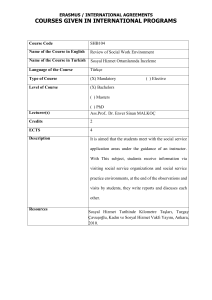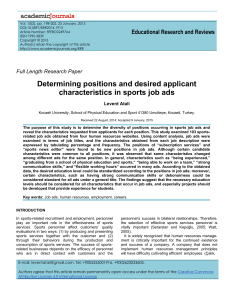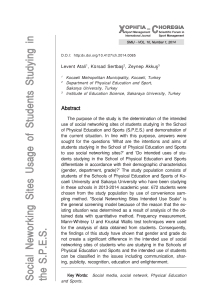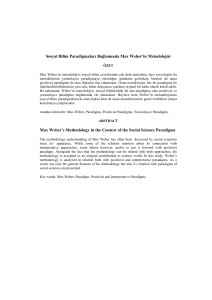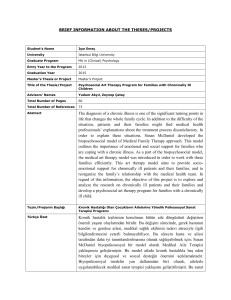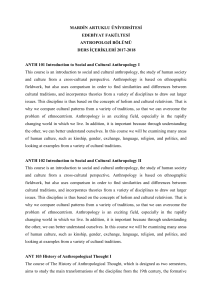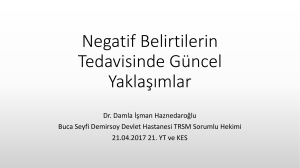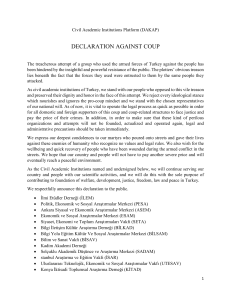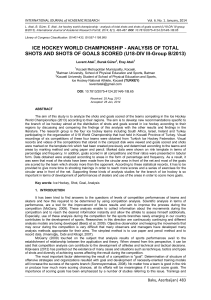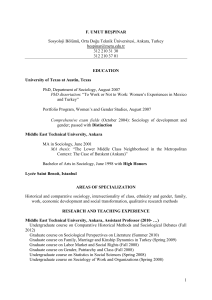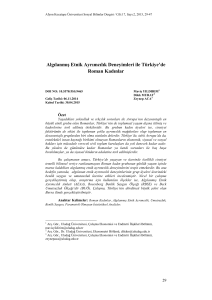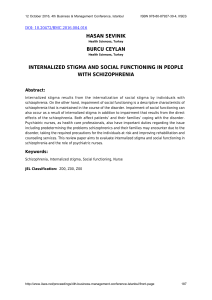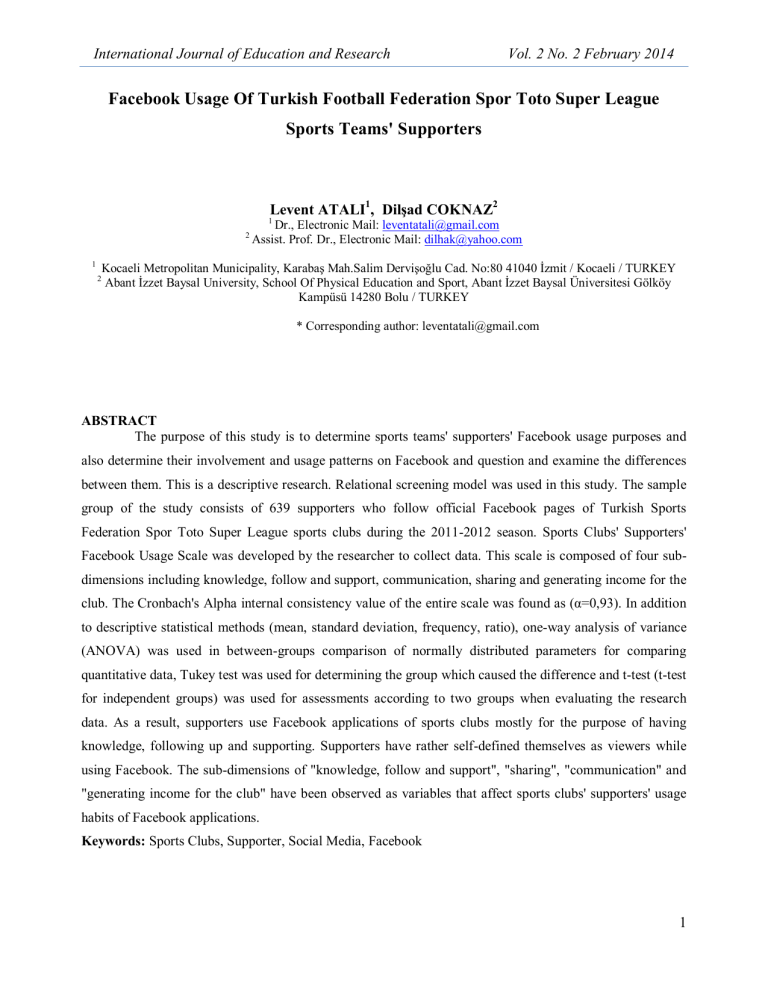
International Journal of Education and Research
Vol. 2 No. 2 February 2014
Facebook Usage Of Turkish Football Federation Spor Toto Super League
Sports Teams' Supporters
Levent ATALI1, Dilşad COKNAZ2
1
2
1
2
Dr., Electronic Mail: [email protected]
Assist. Prof. Dr., Electronic Mail: [email protected]
Kocaeli Metropolitan Municipality, Karabaş Mah.Salim Dervişoğlu Cad. No:80 41040 İzmit / Kocaeli / TURKEY
Abant İzzet Baysal University, School Of Physical Education and Sport, Abant İzzet Baysal Üniversitesi Gölköy
Kampüsü 14280 Bolu / TURKEY
* Corresponding author: [email protected]
ABSTRACT
The purpose of this study is to determine sports teams' supporters' Facebook usage purposes and
also determine their involvement and usage patterns on Facebook and question and examine the differences
between them. This is a descriptive research. Relational screening model was used in this study. The sample
group of the study consists of 639 supporters who follow official Facebook pages of Turkish Sports
Federation Spor Toto Super League sports clubs during the 2011-2012 season. Sports Clubs' Supporters'
Facebook Usage Scale was developed by the researcher to collect data. This scale is composed of four subdimensions including knowledge, follow and support, communication, sharing and generating income for the
club. The Cronbach's Alpha internal consistency value of the entire scale was found as (α=0,93). In addition
to descriptive statistical methods (mean, standard deviation, frequency, ratio), one-way analysis of variance
(ANOVA) was used in between-groups comparison of normally distributed parameters for comparing
quantitative data, Tukey test was used for determining the group which caused the difference and t-test (t-test
for independent groups) was used for assessments according to two groups when evaluating the research
data. As a result, supporters use Facebook applications of sports clubs mostly for the purpose of having
knowledge, following up and supporting. Supporters have rather self-defined themselves as viewers while
using Facebook. The sub-dimensions of "knowledge, follow and support", "sharing", "communication" and
"generating income for the club" have been observed as variables that affect sports clubs' supporters' usage
habits of Facebook applications.
Keywords: Sports Clubs, Supporter, Social Media, Facebook
1
ISSN: 2201-6333 (Print) ISSN: 2201-6740 (Online)
www.ijern.com
1. Introduction
Computer and internet technologies that leave their marks in era have infiltrated up to the deepest
of levels of social life. In recent years, it draws attention that city life technologies and new communication
technologies have intertwined and the users of these technologies create significant changes in terms of
production and sharing (Akar, 2011). The increase in internet usage parallel to this change in Turkey such as
the same with the world and transformation of internet into a part of business life has become inevitable.
Significant portion of those in digital media get in contact with the others with the purposes of mutual
information exchange and share many operations. This communication style in the nature of information
exchange at the beginning of internet usage is now also started to take commercial and promotional
operations into its scope. Exchanges and changes in information and experience related to these exchanges
have began to emerge along with the leaguing of people who need certain products and services together by
increasing in digital media according to their common requirements (Tosun, 2010).
A giant in size and easy-sharing platform that have never happened before on Earth has come into
our lives together with the social media phenomenon (Kahraman, 2010). Blossom (2009) defines social
media as scalable and accessible communication technologies or techniques which enable each individual to
affect other individual groups easily.
Social media that is also known as a digital community is an application that bring people together in
a common platform where they can talk, chat, share their opinions and knowledge and make new friends
(Marketing Leadership Council, 2008). As in each media, social media needs an environment to exist. The
only common point of different technologies and all these tools that use different methods is the fact that
they offer high level of sharing opportunity to their users (Kahraman, 2010). New media with the digital
capability also provides the ability of interaction to its users at the same time. New communication methods
are effective in formation of new social structures by providing re-formation of social structure and relations
of production by these new features of its own (Tosun, 2010).
Sports clubs that are one of the sports organizations are distinguished with their intense presence in
social networking and large majority of users. Number of sports clubs and supporters that are included in
Facebook application which is one of the social networking sites are increasing day by day. The increasing
growth of number of supporters who become member of the relevant applications of sports clubs on
Facebook makes this area very significant and important. The mutual usage purposes of social networking
sites that are used intensively by clubs and supporters continue to gain importance in terms of relations
between sports clubs and supporters. The existence of sports clubs and supporter groups on this new
environment and media that has attained a great place in today's economy has become inevitable. Social
media applications seem to be an opportunity for sports clubs in terms of marketing, public relations,
supporter communication and the other management applications that they need to reach supporter groups.
The need for examination of social networking sites in the field of sports has emerged along with the fact that
2
International Journal of Education and Research
Vol. 2 No. 2 February 2014
sports began to take place in social networking sites as a field with strong attractiveness and has a great
number of viewers.
From the perspective of football, the competition that has been seen on the streets and in the
stadiums will be seen to continue in the digital environment, too. The unlimited communication phenomenon
provided by the internet may affect supporters and form public opinion by forming pressure groups thanks to
the internet environment (Dikici, 2009). It is expected for clubs which make use of this opportunity to step
forward. FC Barcelona may be given as an example to these clubs for the reason that they continue to form
new distribution channels by creating mobile content under the title of new media (Liaguno, Cusco and
Ciurans, 2010). New technologies in social media have increased the number of supporters and have been
caused the emergence of a new supporter group. In this regard, new technologies are largely influenced
sports (Rein and Kotler, 2006). The effect of Facebook which is one of the social media tools is significant in
increasing the number of supporters of sports clubs, today.
One of the important reasons of conduction of this study is the social media applications which are
new for our social life to be expected to add new information to this area in terms of sports clubs and
supporters. The purpose of this study is to examine the sports clubs' supporters' usage purposes of Facebook
and determine the involvement and usage pattern of them and question the differences between these two
aspects.
2. Method
This is a descriptive research. Relational screening model was used in this study. SPSS Windows
2010 software was used for statistical analyses. In addition to descriptive statistical methods (mean, standard
deviation, frequency, ratio), one-way analysis of variance (ANOVA) was used in between-groups
comparison of normally distributed parameters for comparing quantitative data, Tukey test was used for
determining the group which caused the difference and t-test for independent groups was used for
assessments according to two groups when evaluating the research data.. Significance level was determined
as p<0,05.
2.1 Sample
Target population of the study includes supporters who follow (N=15.403.477) official Facebook
page of the Turkish Sports Federation Spor Toto Super League sports clubs during the 2011-2012 season.
Sample-size reference table suggested by Yazicioglu and Erdogan (2004) was used for determining sample
size in terms of the target population of the study. Although sample size of the study was defined as
minimum 384 supporters in a confidence interval of 95% in terms of the suggested sizes, total 639 supporters
who follow Facebook pages of the sports clubs were reached by convenience sampling method. Convenience
sampling is a method providing the persons whose information and data are easiest to collect to be included
in the sample group (Kurtulus, 2006).
3
ISSN: 2201-6333 (Print) ISSN: 2201-6740 (Online)
www.ijern.com
2.2. Data Collection
“Sports Clubs’ Supporters’ Facebook Usage Scale” (SCSFUS) including 29 items was developed
for this study. The scale is composed of four sub-dimensions including “knowledge, follow and support”,
“communication”, “sharing” and “generating income for the club”. The Cronbach's Alpha internal
consistency value of the entire scale was found as (α=0,93). Questions about demographic features and
Facebook usage were added to the first part of the scale. A message link was sent to the Facebook pages of
the Turkish Sports Federation Spor Toto Super League sports clubs and other Facebook pages concerning
sports. 639 scale forms completely filled out by the supporters via this link were evaluated.
3. Findings and Evaluation
Table 1. Mean Scale Score Distribution in terms of Facebook Usage Purposes
Facebook Usage
Purposes
Knowledge, Follow and
Support
Sharing
Communication
Generating Income for
the Club
Min-Max
1,09-5,00
Mean ±
SD
3,25±1,08
Arithmetic
Mean
3,36
1,00-5,00
1,38-4,38
1,00-5,00
2,81±0,94
2,68±0,59
2,32±1,06
2,80
2,50
2,20
“Knowledge, follow and support” sub-dimension ( ̅ =3.36) is distinguished among purposes. As is
known, the phenomenon of supportership includes the support of persons for their own teams or clubs in
any way. It is also a known fact that supporters follow their teams and need to know about them. In the
study conducted on football supporters by Tutkun, Tasmektepligil, Canbaz, Acar and Can (2012), it was
seen that the supporters used internet mostly for informative purposes. In this context, it can be seen as a
probable outcome that the sub-dimension of “knowledge, follow and support” is distinguished among
other usage purposes; because obtaining information is one of the most common purposes of using social
media. For example, Parlak (2010) determined the purposes of using social media as making friends,
communicating and talking with group of friends as well as obtaining information quickly. Similarly,
Karaduman and Kurt (2010) determined obtaining information as one the purposes of using social media
and defined other purposes as communicating, researching, getting informed, sharing and socializing.
Sharing and communication purposes determined in this research are also common in many studies like
the purpose of obtaining information (Karaduman and Kurt, 2010; Koksal, 2012; Parlak, 2010).
According to another research supporting the results, social media is used for obtaining information,
communicating, sharing and contacting (Hazar, 2011). Sener (2009), on the other hand, prioritized the
purposes of Facebook usage as communicating, finding friends and sharing in his study concerning
4
International Journal of Education and Research
Vol. 2 No. 2 February 2014
Facebook usage. Besides all these results, people’s demand to reach information and the technology
satisfying this demand in an easy, quick and cheap way in today’s world are also essential (Cetin, 2009).
In general terms, Facebook usage purposes determined in all studies are similar to the purposes of sports
clubs’ supporters; only the sub-dimension of “generating income for the club” pertains to the sports
clubs.
Table 2. Facebook usage frequency, duration of following the club’s page and percentage and frequency
distributions of the tools used for logging to Facebook
Variables
Facebook
Usage Frequency
Duration of following the club’s
page
Tools used for logging to
Facebook
1 day a week
2-3 days a week
4-5 days a week
6-7 days a week
Less than 1 year
1-2 years
3-4 years
Computer
Computer + Phone
n
42
94
214
289
218
314
107
%
6,6
14,7
33,5
45,2
34,1
49,1
16,7
Total
300
339
46,9
53,1
639
639
639
According to Table 2, while 6.6% (n=42) of the supporters use Facebook one day a week, 14.7%
(n=94) use two or three days a week, 33.5% (n=214) use four or five days a week, and 45.2% (n=289) use
six or seven days a week. According to the findings concerning duration of following the club’s page, 34.1%
(n=218) of the supporters have been following the Facebook page of their club for less than a year, 49.1%
(n=314) are for 1-2 years, and 16.7% (n=107) are for 3-4 years. While 46.9% (n=300) of the supporters login
to Facebook from computer, 53.1% (n=339) login from computer and phone.
According to the findings, most of the sports clubs’ supporters use Facebook applications almost
every day. Considering the history of Facebook applications in our country and especially the beginning of
sports clubs applications, it’s likely to say that sports clubs’ supporters have been following the Facebook
pages of their clubs since the very first years of the application. Moreover, it can be said that Facebook has
become part of daily lives of sports clubs’ supporters taking into consideration that they use Facebook every
day. In the research of Karaduman and Kurt (2010) conducted on business administration students, it was
also mentioned that students used social media intensively every day. According to the findings, nearly half
of the sports clubs’ supporters login into Facebook both from computer and phone. It shows that supporters
are online in Facebook all day long when their usage frequency is also regarded. In the article of Gedizoglu
(2011) including the ideas of Avea Corporate Communications Manager Feridun, social media is considered
and adopted as a new communication model rather than an environment as it allows establishing a mutual,
continuous and dynamic relationship between customers and shareholders rather than a unilateral one. Social
media provides great opportunities for brands always standing by their customers. Besides, the most
5
ISSN: 2201-6333 (Print) ISSN: 2201-6740 (Online)
www.ijern.com
significant target of social media for corporations is to become a subject of customers’ conversation. That’s
why sports clubs’ evaluations concerning such usage of mobile tools are important for Facebook applications
aimed at sports clubs’ supporters. Because, existence of a supporter group accessible at any time has the
potential to allow sports club to communicate with its supporters at any time.
Table 3. Distribution of involvement of supporters in Facebook
Involvement in Facebook
Content Creator
Commentator
Follower
Contributor
Viewer
n
61
161
148
160
317
%
9,5
25,2
23,2
25,0
49,6
According to Table 3, it is seen that 9,5% (n=61) of the supporters are "content creator", 25,2%
(n=161) are "commentator", 23,2% are (n=148) "follower", 25% (n=160) are "contributor" and 49,6%
(n=317) are "viewer".
According to the content of involvement pattern (Evans, 2010), "content creators" and those who
design/set up blogs, Wikis, forums etc. are socially active people. "Content creators" have the minimum rate
(9,5%) among sports team supporters according to this study. This ratio of distribution in this involvement
pattern is an ordinary and normal situation that when considered that having or learning different knowledge
relating to Facebook application and computer areas is required to create content. In other words, a person
must have knowledge about content creation at a certain level to create content. This fact may be accepted as
an indication that supporters do not have enough knowledge and skills to create content. However, these
ratios may likely change depending on usage and knowledge acquisition of supporters in time.
On the contrary, supporters who self-define themselves as "viewers" have the highest ratio
(49,6%). According to Evans (2010), viewers are a large group of supporters who like to sit back and view
pages, make new friends on media and follow their friends and their current news. According to this
definition, it can be argued that Facebook applications provide opportunity of contribution and participation
easily without having or learning different information according to the involvement pattern or the other
involvement patterns of a viewer. Therefore, it can be considered that Facebook is preferred by supporters
because of the reason that it is a new application area and an involvement pattern which does not require so
much information and knowledge and easy to involve in. On the other hand, the ratios of involvement
patterns of "commentators", "followers" and "contributors" are close to each other. "Commentators" like to
evaluate products, services and opinions by taking part in social media by writing their opinions and
comment about products and services and responding forums. "Followers" are people who like to find and
share things on the internet. Contributive people (contributors) are usually online at places where
communities or groups are created and formed and chatted and experiences are shared in certain and specific
6
International Journal of Education and Research
Vol. 2 No. 2 February 2014
topics. In this case, it can be said that three different roles are realized among "supporters" and
"commentators" can be said to realize "follower" and "contributor" roles along with their own role at the
same time.
Table 4. Analysis of Facebook Usage Purposes by age groups
Usage Purposes
Knowledge,
Follow and
Support
Communication
Sharing
Generating
Income for the
Club
*p<0,05
Between-groups
Within-groups
Total
Between-groups
Within-groups
Total
Between-groups
Within-groups
Total
Between-groups
Within-groups
Total
**p<0,01
Sum of
Squares
33,47
710,48
743,95
1,52
221,95
223,47
12,33
558,45
570,78
15,35
702,98
718,32
Degree of
Freedom
4,00
634,00
638,00
4,00
634,00
638,00
4,00
634,00
638,00
4,00
634,00
638,00
Mean of
Squares
8,37
1,12
F
p
7,47
0,001**
0,38
0,35
1,09
0,363
3,08
0,88
3,50
0,008**
3,84
1,11
3,46
0,008**
When analysis results of the Usage Purposes of Facebook by age groups in Table 4 are examined; a
significant difference with respect to the sub-dimensions of "knowledge, follow and support"
[F(4;634)=7,47; p<0,01], "sharing" [F(4;634)=1,09; p<0,05] and "generating income for the club"
[F(4;634)=3,46; p<0,05] was found but a statistically significant difference with respect to communication
[F(4;634)=3,50; p>0,05] was not found.
Table 5. Post- Hoc Analysis of Facebook Usage Purposes by age groups
Knowledge, Follow and Support
Communication
Sharing
Generating Income for the Club
*p<0,05
Age
18-24
25-31
18-24
32-38
18-24
39-45
18-24
25-31
18-24
32-38
18-24
25-31
18-24
32-38
18-24
39-45
̅ ± SD
3,57±1,02
3,05±1,19
3,57±1,02
3,12±9,99
3,57±1,02
3,09±1,03
3,01±1,01
2,68±0,93
3,01±1,01
2,72±0,84
2,54±1,14
2,25±1,05
2,25±1,05
2,23±1,00
2,23±1,00
2,14±0,94
p
0,001**
0,001**
0,007**
0,009**
0,0041**
0,049*
0,048**
0,044*
**p<0,01
As a result of comparisons made in order to determine the age group which causes the difference
7
ISSN: 2201-6333 (Print) ISSN: 2201-6740 (Online)
www.ijern.com
by age groups according to the scores of "knowledge, follow and support"; a statistically significant
difference was found between 18-24 age group ( ̅ = 3,57±1,02), 25-31 age group ( ̅ = 3,05±1,19) (p<0.01),
32-38 age group ( ̅ = 3,12±0,99) (p<0.01) and 39-45 age group ( ̅ = 3,09±1,03) (p<0.01). Considering
arithmetic means in order to determine to which group this difference is in favor of; the score of usage
purposes of "knowledge, follow and support" of 18-24 age group is seen higher than the scores of 32-38 and
39-45 age groups. As a result of comparisons made in order to determine the age group causing the
difference by scores of "sharing" for age groups; a statistically significant difference was found between 1824 age group ( ̅ = 3,01±1,01) and 25-31 age group ( ̅ = 2,68±0,93), 32-38 age group ( ̅ = 2,72±0,84)
(p<0.01). Considering arithmetic means in order to determine to which group this difference is in favor of;
the score of usage purposes of "sharing" of 18-24 age group is seen higher than the scores of 25-31 and 3238 age groups. As a result of comparisons made in order to determine the age group causing the difference
by scores of "generating income for the club" for age groups; a statistically significant difference was found
between 18-24 age group ( ̅ = 2,54±1,14) (p<0,05) and 25-31 age group ( ̅ = 2,25±1,05) (p<0.01), 32-38 age
group ( ̅ = 2,23±1,00) (p<0.01) and 39-45 age group ( ̅ = 2,14±0,94) (p<0,05). Considering arithmetic
means in order to determine to which group this difference is in favor of; the score of usage purposes of
"generating income for the club" of 18-24 age group is seen higher than the scores of 25-31, 32-38 and 39-45
age groups.
As a result of comparisons made in order to determine the age group causing the difference by the
sub-dimension of "knowledge, follow and support", the score of 18-24 age group was found significantly
higher. According to the study conducted by Ada et. al. (2013) on university students; it was reported that
university students are more willing to use social media applications by dimension of information search.
Hazar (2011) has revealed that students use social media mostly to get information according to the result of
his study that he conducted on students. The finding that students use internet to get more informed which is
a result of another study conducted by Karaduman and Kurt (2010) shows parallelism with findings
belonging to 18-24 age group of sports clubs' supporters by the sub-dimension of "knowledge, follow and
support" and Facebook usage. As a result of comparisons made in order to determine the age group causing
the difference by sub-dimension of "sharing", the score of 18-24 age group was found significantly higher.
Hazar (2011) revealed that social media is mostly used for sharing by this age group according to the results
of his study and Karaduman and Kurt (2010) reported that students are disposed to use internet in order to
share things according to the results of their study. As a result of comparisons made in order to determine the
age group causing the difference by sub-dimension of "generating income for the club", the score of 18-24
age group was found significantly higher. Koseoglu (2013) revealed only the variable of age as a significant
difference in terms of demographic variables in his study and stated that mostly information is produced for
the same age group and areas such as brands and advertisement draw attention on Facebook. It can be argued
that this age group of sports clubs' supporters shows interest to sports clubs with the purpose of supporting
sports clubs at the dimension of "generating income for the club". The similar results of this study may be
interpreted as the way that young people have more willing to be informed and desire to learn and share all
these with their friends. It can be argued according to these results that most of sports clubs' supporters'
8
International Journal of Education and Research
Vol. 2 No. 2 February 2014
Facebook users consist of young people and innovations are followed by these young people. Zafarmand
(2010) predicts that future will bring more technology-based businesses as a result of intense interest of
young people on new media. Parlak (2010) stated that young generation is dominant among people who use
social media websites. Articulation of Durmus, Yurtkoru, Ulusu and Kilic (2010) which argues Facebook
users are mainly composed of young people shows parallelism with the results of the research.
Table 6. Comparison of Facebook Usage Purposes by Facebook Usage Frequency
ANOVA
Knowledge, Follow
and Support
Communication
Sharing
Generating Income
for the Club
Between-groups
Within-groups
Total
Between-groups
Within-groups
Total
Between-groups
Within-groups
Total
Between-groups
Within-groups
Total
Sum of Degree of
Squares Freedom
4,26
3
739,69
635
743,95
638
0,54
3
222,93
635
223,47
638
1,11
3
569,67
635
570,78
638
6,58
3
711,74
635
718,32
638
Sum of
Squares
1,42
1,16
F
p
1,22
0,302
0,18
0,35
0,51
0,673
0,37
0,90
0,41
0,744
2,19
1,12
1,96
0,119
The scores of sports clubs’ supporters in the sub-dimensions of “knowledge, follow and support”
[F(3;635)=1,22; p>0,05], “communication” [F(3;635)=0,51; p>0,05], “sharing” [F(3;635)=0,41; p>0,05] and
“generating income for the club” [F(3;635)=1,96; p>0,05] do not differ in a statistically significant way by
weekly Facebook usage frequency. The scores of sports clubs’ supporters participated in the study in the subdimensions of “knowledge, follow and support”, “communication”, “sharing” and “generating income for the
club” do not differ in a statistically significant way by weekly Facebook usage frequency. Therefore, it’s
likely to say that there is no difference between Facebook usage frequency and Facebook usage purposes of
sports clubs’ supporters. As a result of comparisons made in order to determine the group causing the
difference in all sub-dimensions, certain differences were determined in the group who has been following
their club’s page for less than a year. It can be said the reason for this group to differ is that they’re new in
this field and don’t know several applications and Facebook usage purposes. In his research concerning
Facebook usage, Koseoglu (2013) set forth that the longer the Facebook usage duration is, the more the
usage differences are. He also stated that the ones who have been using Facebook for a longer time share
more things and give more importance in the dimension of Facebook usage.
Table 7. Analysis of Facebook usage purposes by duration of Facebook usage
ANOVA
Knowledge,
Follow and
Support
Between-groups
Within-groups
Total
Sum of
Squares
59,40
684,55
743,95
Degree of
Freedom
2
636
638
Sum of
Squares
29,70
1,08
F
p
27,59
0,001**
9
ISSN: 2201-6333 (Print) ISSN: 2201-6740 (Online)
Between-groups
Within-groups
Total
Between-groups
Sharing
Within-groups
Total
Between-groups
Generating Income
Within-groups
for the Club
Total
**p<0,01
Communication
4,58
218,90
223,47
23,83
546,95
570,78
13,46
704,86
718,32
www.ijern.com
2
636
638
2
636
638
2
636
638
2,29
0,34
6,65
0,001**
11,91
0,86
13,85
0,001**
6,73
1,11
6,07
0,001**
Concerning analysis results of Facebook usage purposes by duration of Facebook usage; a
statistically difference was found with respect to sub-dimensions of "knowledge, follow and support"
F(2;636)=27,59; p<0,01], "communication" F(2;636)=6,65; p<0,01], "sharing" F(2;636)=13,85; p<0,01] and
"generating income for the club" F(2;636)=6,07; p<0,01].
Table 8. Post-Hoc Analysis of Facebook Usage Purposes by the Duration of Facebook Usage
Usage Purposes
Knowledge, Follow
and Support
Communication
Sharing
Generating Income
for the Club
**p<0,01
Usage Duration
< 1 year
1-2 years
< 1 year
3-4 years
< 1 year
3-4 years
< 1 year
1-2 years
< 1 year
3-4 years
< 1 year
1-2 years
̅ ± SD
2,84±1,14
3,42±0,95
2,84±1,14
3,60±1,07
2,66±0,53
2,51±0,61
2,55±0,98
2,94±0,89
2,55±0,98
3,00±0,93
2,12±1,07
2,44±1,03
P
0,001**
0,001**
0,001**
0,001**
0,001**
0,002**
As a result of comparisons made in order to determine the group causing the difference in the
scores of "knowledge, follow and support" by the duration of following club’s Facebook page, a statistically
significant difference was determined between the group who has been following their club’s page for less
than a year ( ̅ =2,84±1,14), the ones who have been following for 1-2 years ( ̅ =3,42±0,95) (p<0.01) and the
ones who have been following for 3-4 years ( ̅ =3,60±1,07) (p<0.01). When arithmetic means are considered,
it’s seen that the usage purpose of sharing is less often preferred by the ones who have been following their
club’s page for less than a year compared to the ones who have been following for 1-2 years and the ones
who have been following for 3-4 years. As a result of comparisons made in order to determine the group
causing the difference in the scores of "communication" by the duration of following club’s Facebook page,
a statistically significant difference was determined between the group who has been following their club’s
page for less than a year ( ̅ =2,66±0,53) and the ones who have been following for 3-4 years ( ̅ =2,51±0,61)
(p<0,01). And considering arithmetic means, it’s seen that the score of the ones who have been following
10
International Journal of Education and Research
Vol. 2 No. 2 February 2014
their club’s page for less than a year is higher than the ones who have been following for 3-4 years. As a
result of comparisons made in order to determine the group causing the difference in the scores of "sharing"
by the duration of following club’s Facebook page, a statistically significant difference was determined
between the group who has been following their club’s page for less than a year ( ̅ =2,55±0,98), the ones who
have been following for 1-2 years ( ̅ =2,94±0,89) (p<0.01) and the ones who have been following for 3-4
years ( ̅ =3,00±0,93) (p<0.01). When arithmetic means are considered, it’s seen that the usage purpose of
sharing is less often preferred by the ones who have been following their club’s page for less than a year
compared to the ones who have been following for 1-2 years and the ones who have been following for 3-4
years. As a result of comparisons made in order to determine the group causing the difference in the scores of
"generating income for the club" by the duration of following club’s Facebook page, a statistically significant
difference was determined between the group who has been following their club’s page for less than a year
( ̅ =2,12±1,07)
and the ones who have been following for 1-2 years ( ̅ =2,44±1,03) (p<0,01). And
considering arithmetic means, it’s seen that the score of the ones who have been following their club’s page
for less than a year is lower than the ones who have been following for 1-2 years. When sports clubs’
supporters are evaluated according to the duration of following their clubs’ pages, it’s seen that the results
are in favor of the ones who have been following their clubs’ page for a longer time in parallel with the
results in the literature.
Table 9. Analysis of Facebook usage purposes by the user variable of "content creator"
Usage Purposes
Knowledge, Follow
and Support
Communication
Sharing
Generating Income
for the Club
Option
Yes
No
Yes
No
Yes
No
Yes
No
N
61
578
61
578
61
578
61
578
Mean
3,36
3,24
2,93
2,65
3,06
2,79
2,73
2,28
SD
1,30
1,05
0,61
0,58
1,14
0,92
1,33
1,02
t
0,692
P
0,492
0,357
0,001**
0,180
0,072
2,589
0,012*
The score of "communication" [t(0,61)=0,357; p:0,001] of group who self-defines themselves as
"content creator" and creates content on Facebook and score of "generating income for the club"
[t(1,33)=2,589; p:0,012] were found significantly higher. A significant difference could not be found
between the score of "knowledge, follow and support" and score of "sharing" of those who self-define
themselves as "content creator" (p>0,05).
The score of "knowledge, follow and support" [t(1,07)=0,703; p:0,482], the score of
"communication" [t(0,61)=0,196; p:0,844], the score of "sharing" [t(0,92)=0,059; p:0,953] and the score of
"generating income for the club" [t(1,03)=0,854; p:0,394] do not show statistically significant difference for
those who self-define themselves as users who comment on Facebook. ("commentators") The score of
"knowledge, follow and support" [t(1,08)=0,168; p:0,867], the score of "communication" [t(0,58)=0,955;
11
ISSN: 2201-6333 (Print) ISSN: 2201-6740 (Online)
www.ijern.com
p:0,240], the score of "sharing" [t(0,97)=0,193; p:0,850] and the score of "generating income for the club"
[t(1,12)=0,827; p:0,408] do not show statistically significant difference for those who self-define themselves
as users who follow themselves and the others on Facebook. ("followers") The score of "knowledge, follow
and support" [t(0,95)=0,04; p:0,964], the score of "communication" [t(0,61)=1,280; p:0,201], the score of
"sharing" [t(0,85)=0,073; p:0,934] and the score of "generating income for the club" [t(1,00)=0,080; p:0,936]
do not show statistically significant difference for those who self-define themselves as users who contribute
on Facebook ("contributors"). The score of "knowledge, follow and support" [t(1,05)=0,869; p:0,385], the
score of "communication" [t(0,55)=0,110; p:0,913], the score of "sharing" [t(0,90)=0,951; p:0,342] and the
score of "generating income for the club" [t(1,00)=1,035; p:0,192] do not show statistically significant
difference for those who self-define themselves as viewers on Facebook ("viewers").
Table 10. Analysis of Facebook usage purposes by the user variable of "commentator"
Usage Purposes
Knowledge, Follow and
Support
Communication
Sharing
Generating Income for
the Club
Option
Yes
No
Yes
No
Yes
No
Yes
No
N
161
478
161
478
161
478
161
478
Mean
3,20
3,27
2,69
2,68
2,81
2,81
2,39
2,30
SD
1,07
1,08
0,61
0,59
0,92
0,95
1,03
1,07
t
0,703
P
0,482
0,196
0,844
0,059
0,953
0,854
0,394
The score of "knowledge, follow and support" [t(1,07)=0,703; p:0,482], the score of
"communication" [t(0,61)=0,196; p:0,844], the score of "sharing" [t(0,92)=0,059; p:0,953] and the score of
"generating income for the club" [t(1,03)=0,854; p:0,394] do not show statistically significant difference for
those who self-define themselves as commentators on Facebook ("commentators").
Table 11. Analysis of Facebook usage purposes by the user variable of "follower"
Usage Purposes
Knowledge, Follow and
Support
Communication
Sharing
Generating Income for
the Club
Option
Yes
No
Yes
No
Yes
No
Yes
No
N
148
491
148
491
148
491
148
491
Mean
3,26
3,25
2,64
2,69
2,83
2,81
2,39
2,31
SD
1,08
1,08
0,58
0,60
0,97
0,94
1,12
1,04
t
0,168
P
0,867
0,955
0,340
0,193
0,850
0,827
0,408
The score of "knowledge, follow and support" [t(1,08)=0,168; p:0,867], the score of
"communication" [t(0,58)=0,955; p:0,240], the score of "sharing" [t(0,97)=0,193; p:0,850] and the score of
"generating income for the club" [t(1,12)=0,827; p:0,408] do not show statistically significant difference for
those who self-define themselves as followers on Facebook ("followers").
12
International Journal of Education and Research
Vol. 2 No. 2 February 2014
Table 12. Analysis of Facebook usage purposes by the user variable of "contributor"
Usage Purposes
Knowledge, Follow and
Support
Communication
Sharing
Generating Income for
the Club
Option
Yes
No
Yes
No
Yes
No
Yes
No
N
160
479
160
479
160
479
160
479
Mean
3,25
3,25
2,63
2,70
2,81
2,81
2,32
2,33
SD
0,95
1,12
0,61
0,58
0,85
0,98
1,00
1,08
t
0,04
P
0,964
1,280
0,201
0,073
0,934
0,080
0,936
The score of "knowledge, follow and support" [t(0,95)=0,04; p:0,964], the score of
"communication" [t(0,61)=1,280; p:0,201], the score of "sharing" [t(0,85)=0,073; p:0,934] and the score of
"generating income for the club" [t(1,00)=0,080; p:0,936] do not show statistically significant difference for
those who self-define themselves as contributors on Facebook ("contributors").
Table 13. Analysis of Facebook usage purposes by the user variable of "viewer"
Usage Purposes
Knowledge, Follow and
Support
Communication
Sharing
Generating Income for
the Club
Option
Yes
No
Yes
No
Yes
No
Yes
No
N
317
322
317
322
317
322
317
322
Mean
3,29
3,21
2,68
2,68
2,78
2,85
2,27
2,38
SD
1,05
1,11
0,55
0,63
0,90
0,99
1,00
1,11
t
0,869
P
0,385
0,110
0,913
0,951
0,342
1,035
0,192
The score of "knowledge, follow and support" [t(1,05)=0,869; p:0,385], the score of
"communication" [t(0,55)=0,110; p:0,913], the score of "sharing" [t(0,90)=0,951; p:0,342] and the score of
"generating income for the club" [t(1,00)=1,035; p:0,192] do not show statistically significant difference for
those who self-define themselves as viewers on Facebook ("viewers").
Content creators consist of people who are at the top of Forrester's Technographics Ladder and
create a special and private page and share what they created and formed. In this sense, content creators seem
to have the highest level of knowledge and information about social media applications. In this regard, it can
be argued that this group which self-define themselves as content creators may show differences when
compared to other groups because of the fact that they have knowledge about advanced level of usage and
the other usage dimensions. The sports clubs' supporters who self-define themselves as content creator on
Facebook may be argued to use Facebook to communicate and generate income for the club when compared
to the other user groups.
13
ISSN: 2201-6333 (Print) ISSN: 2201-6740 (Online)
www.ijern.com
4. Conclusion
In general terms, Facebook usage purposes revealed in all studies are similar to the purposes of
sports clubs’ supporters; only the sub-dimension of “generating income for the club” pertains to the sports
clubs.
Considering the sports clubs’ supporters use of their clubs’ Facebook applications, there are certain
variables affecting their usage in the sub-dimensions of “knowledge, follow and support”, “communication”,
“sharing” and “generating income for the club” that are considered as the Facebook usage purposes. It was
determined that sports clubs’ supporters were using Facebook applications of their club primarily for
“knowledge, follow and support.” Besides, the supporters self-defined themselves mostly as viewer on
Facebook. These results show that there are special Facebook usages for supporters in consideration of the
supporter-sports club relationship.
The role of content creation considered as one of the ways of appearing in Facebook in this study is
the less often preferred role by the supporters. One of the underlying reasons for supporters not to engage in
so many activities concerning content creation can be regarded as one must have a certain level of knowledge
to create content in Facebook. On the other hand, this condition is likely to change in time depending on the
usage and knowledge acquisition. Moreover, there have been certain supporters who play these three
different roles at the same time. In other words, there are supporters who are commentator, follower and
contributor at the same time.
When sports clubs’ supporters are evaluated according to the duration of following their clubs’
pages, it’s seen that the results are in favor of the ones who have been following their clubs’ page for a
longer time in parallel with the results in the literature.
In conclusion, this study is limited with the sports clubs’ supporters who use Facebook that is a
social media application and the sports clubs that are mostly involved in football. It can be suggested that
similar studies to be conducted for different sectors of sports industry to determine how social media is
regarded in the industry based on Facebook.
4. Reference
Ada, S., Çiçek, B. ve Kaynakyeşil, G. (2013). Çevrimiçi sosyal ağ sitesi kullanımını etkileyen motive edici
faktörler üzerine bir araştırma. XIV. Akademik Bilişim Konferansında sunulan bildiri (23-25 Ocak,
Antalya), Antalya: www. ab.org.tr/ab13/206.html.
Akar, E. (2011). Sosyal medya pazarlaması, sosyal web’de pazarlama stratejisi. Ankara: Efil Yayınları.
Blossom, J. Content Nation. Surviving And Thriving As Social Media Changes Our Work, Our Lives, and
Our Future, http://www.contentnation.com. Erişim Tarihi: 20.05 2010.
Çetin, E. (2009) Sosyal iletişim ağları ve gençlik: Facebook örneği. Uluslararası Davroz Kongresi’nde
14
International Journal of Education and Research
Vol. 2 No. 2 February 2014
sunulan bildiri (24-27 Eylül, Isparta, 1094-1105), Isparta
Dikici, S. (2009). Bir başka taraftarlık. Ankara: Dipnot Yayınları.
Durmuş, B., Yurtkoru, S. ve Ulusu, Y., Kılıç, B. (2010). Sosyal paylaşım ağlarının bireylere ve işletmelere
yönelik incelenmesi: Facebook üzerine bir araştırma. İstanbul: Beta Yayıncılık.
Evans, L. (2010). Social media marketing. USA: Pearson Tech Group.
Forrester
Research
(2008)
The
social
technographics
ladder.
http://forrester.typepad.com/.a/6a00d8341c50bf53ef0120a932b364970b-500wi. 02 Mayıs 2013’te erişildi.
Gedizlioğlu, D. (2011). Sosyal medyanın en samimi markaları. MediaCat Pazarlama İletişimi Dergisi, 197,
90-94.
Hacıefendioğlu, Ş. (2010). Sosyal paylaşım sitelerinde üye bağlılığı üzerine. Kocaeli Üniversitesi Sosyal
Bilimler Enstitüsü Dergisi, 2(10), 56-71.
Hazar, M. (2011). Sosyal medya bağımlılığı. Gazi Üniversitesi İletişim Fakültesi İletişim Kuram ve
Araştırma Dergisi, 32, 151-175
Horzum, B. (2010). Öğretmenlerin web 2.0 araçlarından haberdarlığı, kullanım sıklıkları ve amaçlarının
çeşitli değişkenler açısından incelenmesi. Uluslararası İnsan Bilimleri Dergisi, 7(1), 603-634.
İşlek, S. (2012). Sosyal medyanın tüketici davranışlarına etkileri: Türkiye’deki sosyal medya kullanıcıları
üzerine bir araştırma. Yayımlanmamış Yüksek Lisans Tezi, Karaman: Karamanoğlu Mehmetbey Üniversitesi
Sosyal Bilimler Enstitüsü.
Kahraman, M. (2010). Sosyal medya, pazarlamacılar için sosyal medyaya giriş. İstanbul: Mediacat
Yayınları.
Karaduman, M. ve Kurt, H. (2010) İletişim fakültesi öğrencilerinin sosyal medya kullanım düzeyleri, XV.
Türkiye’de internet Konferansında sunulan bildiri (02-04 Aralık, İstanbul), İstanbul Teknik Üniversitesi.
Köksal, Y. (2012). Sosyal medya uygulamalarının pazarlama faaliyet alanı içerisinde kullanım şekilleri
üzerine bir inceleme. KSÜ Sosyal Bilimler Enstitüsü Dergisi, 9 (1), 75-85.
Köseoğlu, Ö. (2013). Bir pazarlama iletişimi ortamı olarak Facebook: reklam ve elektronik ağızdan ağıza
mesajların karşılaştırılmasına yönelik bir analiz. Yeditepe Üniversitesi Global Media Journal, 3(6), 74-101.
Kurtuluş, K. (2006). Pazarlama araştırmaları. İstanbul: Literatür Yayınları.
Leo, M. (2012). Der club der millionare, Social Media & Sport Magazin, 17 Ausgabe 2012, 32-33.
Liaguno, E., Cuscó, R. ve Ciurans, A. (2010). Futbol club Barcelona business economics II Professor: David
Rodríguez. www.iese.edu/research/pdfs/OP-06-12.pdf 02 Mayıs 2013’te erişildi.
Marketing Leadership Council, 2008, www.mlc.executiveboard.com. Erişim Tarihi: 17.05.2010
Parlak, F. (2010). Sosyal medya ve tüketici satın alma karar sürecine etkileri: nitel bir uygulama,
Yayınlanmamış Yüksek Lisans Tezi, Kütahya: Dumlupınar Sosyal Bilimler Enstitüsü.
Sağır, A. (2012). Facebook gruplarında şampiyonluk algısı üzerinden bir taraftarlık kimliği çözümlemesi.
15
ISSN: 2201-6333 (Print) ISSN: 2201-6740 (Online)
www.ijern.com
12. Spor Bilimleri Kongresinde sunulan bildiri (12-14 Kasım, Denizli, ss. 375-376), Denizli.
Şener, G. (2009). Türkiye’de Facebook kullanımı araştırması, XIV. Türkiye’de internet Konferansında
sunulan bildiri (12-13 Aralık, İstanbul), İstanbul Bilgi Üniversitesi.
Tosun, B N. (2010). İletişim temelli marka yönetimi. İstanbul: Beta Yayınları.
Tutkun, E., Taşmektepligil, Y. ve Canbaz, S., Acar, H., Can, M. (2012). Samsunspor taraftarlarının sosyoekonomik özellikleri ve şiddete eğilimleri. Selçuk Üniversitesi Beden Eğitimi ve Spor Bilimleri Dergisi,
14(1), 56-63.
Yazıcıoğlu, Y. ve Erdoğan, S. (2004). SPSS uygulamalı bilimsel araştırma yöntemleri. Ankara: Detay
Yayıncılık.
Zafarmand, N. (2010). Halkla ilişkiler alanında yeni mecra ve uygulamaların yeri ve önemi: sosyal medya ve
PR2.0. Yayımlanmamış Yüksek Lisans Tezi, Ankara
16

